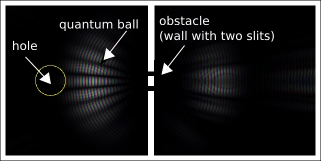
|
The game quantum minigolf is nearly the same as the game
minigolf - except that the ball obeys the laws of quantum
mechanics.
Such a ball can be at several places at once. It
can diffract around obstacles and interfere with itself.
Apart from that, the rules are the same: You can play on
various tracks involving various obstacles. You hit the ball
with a club and try to kick it into a hole on the other side
of the track.
To play quantum minigolf, download the game in the download section. It is a GPLed C++ program, which has been tested under Windows and Linux. It features a simple user interface. You can add your own tracks by editing them in any image editing software and saving them in bmp format.
 |
There also exists a (virtually) real version of quantum
minigolf. It permits to play with a real club and a ball which is
projected onto the track by a video projector mounted on a
2m (6ft) high tripod. The club is marked by an infrared LED,
and detected by a webcam next to the video projector. An image
recognition algorithm in the quantum minigolf software
computes the club position and feeds back hits into the
simulation.
 On the left of each track, you see a yellow ring. This is the
hole. When the ball is inside this region at the end of the
game, you win. Otherwise you lose.
On the left of each track, you see a yellow ring. This is the
hole. When the ball is inside this region at the end of the
game, you win. Otherwise you lose.
The obstacles are white. Their "whiteness" shows their
height. A white spot is
thus a pillar standing out of the playing field. A white area
is a block standing out. A grey area is a block standing out,
but not as high as a white area.
The quantum ball appears as a blob colored in all rainbow
colors. Quantum mechanics tells us that the ball is everywhere
inside the blob at once. But it is
a bit more where the blob is very intense than where it is
barely visible.
For the experts: The ball is visualized by
mapping the complex wavefunction to the color circle. The
modulus of the wavefunction is thus intensity-coded, the phase
is color-coded. See e.g. the books
Visual quantum mechanics for a more
thorough analysis.
At the beginning of each quantum minigolf game, the ball rests
at the drive position (on the right). When you hit it with the
club, it will start to move.
For the experts: Hitting the
ball, you define an initial momentum. The ball is then
initialized as a Gaussian wavepacket of hard-coded width, centered around
the driving position in position space and around the initial
momentum in momentum space.
Once it moves, the ball will cross the track nearly like a classical ball. However you will note peculiar things, such that it tends to spread itself everywhere and that it can flow around obstacles, which shows its quantum-mechanical nature.
 Since a quantum mechanical ball is most of the time at several places at once,
it is impossible to say, whether it is in the hole or not. It
is just "at once inside and outside" the hole. However, there
is a trick: Quantum mechanics allows to make a "position
measurement" which will let the ball collapse at a
certain position. Think of this as taking a photo of the
ball. A quantum particle can be at several places at once -
but on a photo it will always appear on one and only one
positon.
Since a quantum mechanical ball is most of the time at several places at once,
it is impossible to say, whether it is in the hole or not. It
is just "at once inside and outside" the hole. However, there
is a trick: Quantum mechanics allows to make a "position
measurement" which will let the ball collapse at a
certain position. Think of this as taking a photo of the
ball. A quantum particle can be at several places at once -
but on a photo it will always appear on one and only one
positon.
At the end of each game you take thus a virtual photo of the track. If the ball
appears in the hole, you win. Otherwise you lose.